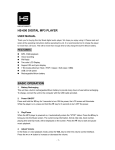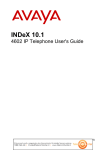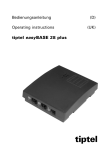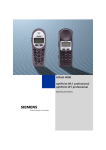Download corporate telephone standards and telephone user guide
Transcript
CORPORATE TELEPHONE STANDARDS AND TELEPHONE USER GUIDE September 2008 INTRODUCTION TO CORPORATE TELEPHONE STANDARDS The 2007 Citizen survey revealed 71% of the Council’s customers contact the organisation by telephone. Currently the Council handles around 50,000 calls a month. Following a mystery caller survey the Council agreed to adopt best practice in telephone handling. Council employees are committed to: use a consistent greeting; acknowledge caller requests (mainly switchboard operators); give warnings and explanations of silences; end calls professionally; reduce the use of answer phones; own calls to reduce the number of callers being passed from one extension to another; talk clearly and slowly; reduce the number of engaged and unanswered lines. The Council continues to carry out mystery caller surveys to ensure a consistent high level of service and to identify opportunities for future improvement. 2 THE STANDARDS IS YOUR GREETING RECOGNISABLE? FRIENDLY AND INSTANTLY The corporate telephone greetings are: For switchboard operators Good morning/afternoon, Cambridge City Council For all staff answering ddi calls (double ring tone) Good morning/afternoon, Human Resources, John Smith For internal calls (single ring tone) The greeting is now the same as the ddi greeting – “Good morning/afternoon, Human Resources, John Smith”. Answering calls in this way helps the caller. It is a recognised fact that callers do not always hear the opening response when a call is answered. They need time to tune into the tone/volume of the person answering their call. This means the initial, “good morning/afternoon", greeting is often missed by the caller. This adjustment time enables the caller to tune in, in time for the important information about the organisation, section and person they are speaking to. 3 CALL TRANSFERS - The standard is to keep the caller informed about what is happening to their call. An example of good practice is: “I am sorry I cannot help you with your enquiry about....., I just transfer you to (name of person or section) who will be able to help you. Please hold while I transfer your call”. When transferring a call it is very important that you state the person’s name (if you know it) and explain what the enquiry is about to the person you are transferring the call to. An example of good practice for the person picking up the transferred call is: “Good morning/afternoon, my name is.............., I understand that you are enquiring about..........”. This provides clarity for the caller, improves customer care and saves the caller having to repeat their enquiry all over again. CALL OWNERSHIP (avoiding callers being passed around) If you receive a call, you must own that call and only transfer it if you are sure you are connecting the caller to the service they require. Alternatively, take the caller’s details and arrange for the appropriate person/service to call back. If you are really stuck you can always put the call back to the switchboard by dialling 0. However, remember the switchboard is often very busy and always gives priority to incoming calls so it might take a little time for your call to be answered. If you do transfer a caller back to the switchboard please explain the nature of the enquiry to the operator and don’t forget that the caller can hear what is being said. WARNINGS OF SILENCES It is important to warn callers of impending silences when there is a need to search for more information. The standard is “if you would like to hold, I will just go and find out.............” . Remember the caller cannot see you and needs to be kept informed of what is happening to their call. ENDING THE CALL (for first time contact from a member of the public) Check whether the caller is satisfied; this can be achieved by asking the caller if there is anything else you can help them with. Say thank you; say good-bye and give your name in case they need to call again. 4 DEALING WITH DIFFICULT OR ABUSIVE CALLERS None of us like dealing with angry, impatient, aggressive or abusive callers but sometimes we have to. Difficult calls need to be dealt with very carefully and it is our responsibility to attempt to alter the course of their call from one that a customer might feel is highly unsatisfactory to one where their needs are met. Ownership of the problem is the key, even if you have to pass the call on to resolve it satisfactorily. When dealing with a difficult call consider the needs of the caller: • • • • • • • Try and place yourself in their shoes, imagine how you might feel in the same situation. Most callers do not want to be angry; they will often take a solution if it is offered in an acceptable way. Identifying fault or blame is counterproductive to finding a solution. It does not matter if the cause of the anger or frustration is the Council’s action or lack of it, or the callers’s frustration with their own ability to understand, communicate or follow advice. Focusing on the needs of the caller and offering a solution is a positive response to the situation. Reducing the anger or frustration will create an opportunity to resolve the call. Remember that the caller is not attacking you personally but is reacting to a situation. DO’S Let them talk Acknowledge their anger Focus on the problem Offer a solution Apologise once Own the call DON’TS Take it personally Lose your temper Blame everyone else or make excuses Make rash promises Over apologise Dismiss the problem Sometimes it can be very difficult to follow the above advice, especially if the caller is particularly aggressive, impatient or abusive. If the caller disagrees with Council policy, this is also outside your influence. Sometimes calls go round in circles. If you reach a point where you have dealt with the issue as best and as far as you can, you can close the conversation by saying something such as: ”I don’t think we are going to get much further on the phone today. I have agreed to [re-state action you have agreed to take] OR I have explained that [summarise the situation again] and I don’t think there is anything I can add.” Finally, if a caller is very abusive (using foul or offensive language), stay calm and warn them you will terminate the call if they do not stop speaking in an offensive manner. If they continue then say calmly ”I am putting the phone down now as I am unable to help you any further”. Then put the receiver down immediately, don’t enter into any further conversation. 5 RESPONSE TIMES AND NEW QUALITY STANDARDS FOR THE TELEPHONE SERVICE The Corporately agreed quality standards for answering telephones are: • We aim to answer all ddi calls within 12 seconds (4 rings) • We aim to answer all switchboard calls within 15 seconds (5 rings) (The switchboard service target is higher than that set for ddi lines as the switchboard deals with up to 60 incoming lines at any given time). • We aim to improve the public’s perception of the Council’s telephone service Responsiveness is measured by the Tiger telephone call logger and mystery caller surveys. Service quality is measured by annual mystery caller surveys and Citizens Surveys. TELEPHONE SERVICE QUALITY The aim is to improve the Council’s independent telephone assessment rating by mystery customer calls when further service assessments are carried out. Teleconomy Consulting, who carried out the mystery caller survey, measure an organisation’s performance against a set of standards that represent customer expectations. Teleconomy, Henley Research Centre and Lancaster University developed these standards using customer perception surveys to identify which aspects of a telephone call customer’s rate most highly. The standards therefore enabled the Council to be measured against customer expectations. They also meant the Council’s telephone performance could be benchmarked against any of Teleconomy’s 350 client organisations. All organisations used for benchmarking operated a switchboard/direct dial service similar to the City Council. Improving Corporate Telephone Standards and achieving these quality standards is an excellent way of demonstrating a programme of Best Value Continuous Improvement for all council services. 6 QUALITY OF RESPONSE (call queuing) The standard is that “all calls will be answered by a person not a machine”. All calls to be answered in person during normal office hours i.e. 9am to 5pm Monday to Thursday, 9am to 4.30pm Fridays. This includes all ddi lines. No service should introduce call queuing without specific Corporate Management Team approval. ANSWERPHONES/VOICEMAIL The Council has a Voicemail system that has the following conditions of use: • Users are not Customer facing staff • The user continues to answer their telephone whilst at their desk, and does not use the system as a caller filtering service • That the system is regularly checked by the user for messages, as a guidance 3 to 4 times a day • Greetings are updated regularly. Especially for periods of extended absence • The corporate standard of greeting (outlined below) is used • That users have Manager approval prior to applying through the Serco Service Request. Serco will then double check with the ICT Client Team prior to enabling the service • That the system is monitored and access to the system can be revoked at any time Your Voicemail greeting should include the corporate standard greeting with the following elements: • • • • Your name (also the name of your organisation or department). The date of the week or period of time for which your greeting is valid. What key(s) callers can press on their telephones for immediate assistance. When callers can expect a return call - more specifically than "as soon as possible". • The name and extension number of a colleague who can provide assistance if you are out of the office, a must if you are away for the week. As an example greeting: “Hello, this is Cambridge City Council, and you have reached the voicemail of Tony Allen’s. Please leave your name, message and daytime telephone number after the tone. If you are calling after 5pm we will return your call the next working day. Thank you”. The message can be flexible for any additional information, for example the Personal Assistant: “Hello, this is Cambridge City Council, and you have reached the voicemail of Tony Allen’s. Please leave your name, message and daytime telephone number after the tone. If you would prefer to speak to someone now please press 0”. If you are absent (for example on leave) please amend your greeting as appropriate, for 7 example: “Hello, this is Cambridge City Council, and you have reached the voicemail of Tony Allen. I will be on leave from April 19 until April 25 and will not be checking messages. Please leave your name, message and daytime telephone number after the tone or if you wish to speak to someone please call Terry Bruton on 01223 457436”. Guidance on the voicemail system can be seen at the link below: PUT LINK IN HERE PREMIUM RATE LINES These may be used (after approval by the Director) for commercially orientated services. The message must state very early on the maximum cost of the call. This feature must not be used where the service customers are likely to be from disadvantaged sections of the community. PRE-RECORDED INFORMATION LINES These may be used (following Director approval) for commercially orientated services. The message must state very early on that no message facility exists and give an alternative number where a person can be contacted. 8 USEFUL TIPS FOR HANDLING TELEPHONE CALLS Remember - we are all ambassadors for the Council and you never get a second chance to make a good first impression Are you prepared to answer that call? positive mental attitude take a deep breath smile give 100% attention The message we convey on the telephone is made up of 84% from the tone of our voice and 16% of the actual words we use. Remember callers cannot see us and need to be kept informed of what is happening to their call. Telephone callers cannot see us so it is important to explain what we are doing. They cannot see our facial expression so we need to convey our willingness by letting them hear us smile. 9 Are you listening? • • • • Make listening noises Be aware of caller’s emotions Make mental/written notes of key words and relevant facts Concentrate, ignore distractions Be an active listener! How do you sound? REMEMBER THE CALLER CANNOT SEE YOU Unfriendly Grumpy Rude Negative Muffled Friendly Cheerful Courteous Positive Clear Courtesy is free! Vocabulary Use “please” and “thank you” Be polite and pleasant at all times. Avoid slang Avoid abbreviations Avoid jargon Use positive words. Clear Speech Do not eat and drink whilst on the telephone. Speak slowly and clearly. Keep the mouthpiece clear. 10 Are you in control? • • • • • • • • • Establish and use the other person’s name Give your name Be aware of different types of questioning skills When interrupting, use the caller’s name and give reason for the interruption Take accurate notes and messages Read back information Be aware of good listening skills Be positive Be assertive Are you being informative? • Explain reason for transfer to your caller and to the other extension • When placing a caller on hold inform them of your intention • Check that it is convenient to place a caller on hold • When looking up information - inform the caller of your progress • Volunteer information – don’t wait to be asked. Speak your actions! 11 Are you prepared for that outgoing call? • Do you have an alternative contact name if the person you require is unavailable? • Identify yourself and the reason for your call • Anticipate questions and have relevant information at hand • Be prepared, if asked, to leave a message Know what you want to say and what you want to accomplish. Are you ready to terminate the call? Confirm all relevant facts Clarify action to be taken Double check there are no further points to discuss Ask the caller if there is anything else you can help them with. Then say thank you and goodbye and mean it! 12 Did you take responsibility and own that call? Pass on the message Return the call Po Post the information Update the records Pass on customer compliments 13 ARE YOU FAMILIAR WITH THE TELEPHONE SYSTEM AND YOUR HANDSET? Recall Redial 1 2 3 4 5 6 7 8 9 * 0 # Gain confidence, read this user guide and practice. Features of our telephone system Χ Χ Χ Χ Χ Χ Χ Χ Χ Χ Χ Χ Χ Χ Χ Χ • Call Transfer R (recall) then extension number Enquiry R (recall) then extension number Cancel Enquiry R**1 Hold R*9 Reconnect held party R*1 Call pick up *3 then extension number Group pick up **3 Camp on busy R#1 Camp on ring no reply R#1 Call diversion #9 then extension number required Cancel call diversion ##9 Conference call R then extension then R*4 (A full explanation of the conference call facility is included on page 16) To call main switchboard Dial 0 To obtain an outside line Dial 9 NTL anonymous call bar Dial 185 Ring tones internal call Single ring tone external call Double ring tone To enter PIN number for Private Calls Redial *2 _ _ _ _ # If you need to transfer a caller back or speak to the main switchboard dial 0. When doing this it is important to remember that the caller can hear what is being said. 14 PRE-PROGRAMMED FEATURES OF OUR TELEPHONE SYSTEM (CONTACT THE ICT Client Team or Serco) Call forwarding - It is possible to place this feature on any extension on our telephone network for the following call types: RE: RI: BE: BI: Warning! external calls not answered in 5 rings (15 seconds) will divert to another extension; internal calls not answered in 5 rings (15 seconds) will divert to another extension; external calls that come in when the extension is busy will divert to another extension. internal calls that come in when the extension is busy will divert to another extension. If the extension the call should forward to is busy the original number called will continue to ring. There are a number of ways this problem can be overcome and you should contact the Telephone Manager for advice. Hunt Groups - These are groups of ddi numbers up to a maximum of 20. When a call comes in on a ddi line that is attached to the hunt group it searches for the first available extension in the group. These groups are usually used when the caller needs to speak to a certain section/service rather than an individual. Warning! You cannot place a manual divert within a hunt group as it confuses the telephone system and the call remains unanswered. Distribution Groups - These groups are similar to hunt groups but this group shares out the calls by ringing extensions in sequence rather than going to the first available extension. You can have a maximum of 20 extensions in this type of group. Warning! You cannot place a manual divert in a distribution group. Pick up Groups - These are groups of extensions which can pick up calls ringing other extensions in the group by using **3 code. You can have a maximum of 20 extensions in this type of group. 15 ON-LINE TELEPHONE DIRECTORY All networked City Council PC,s have access to the on-line telephone directory. The directory is easy to use and can be kept open on the desktop while you are logged into the network. The directory has an A to Z with search facility of all Council staff, a section for each Council department, Council fax numbers, City Councillors, First Aiders, a listing of Council Media contacts and County Council e-mail addresses. It also has an A to Z of Council Services section with a search facility. The directory is maintained by Cambridge City Council and is updated on a regular basis. Any changes to the directory should be notified to Serco and/or Terry Bruton. PROCEDURE FOR MAKING A PRIVATE PHONE CALL If you want to make a private telephone call take the following steps: Χ Dial the number you require in the usual manner; Χ On answer or anytime while the call is connected dial R*2 followed by your 4 digit pin number, then #. Pin numbers are issued by your departmental admin. Χ You will then be reconnected to the person you are calling and the call will be charged to you at a later date. Χ You can also enter your pin number before replacing the handset at the end of your call. GROUPWISE TELEPHONE MESSAGE FACILTY Go to the top left hand corner of your GroupWise Mailbox. File New Phone Message It’s quicker, safer and cheaper than using post it notes or scraps of paper. It also provides a permanent record that you passed the message on. CONFERENCE CALL A conference call enables up to six telephone users to speak to each other at one time. However, only one of the calls can be external. You are already connected to the first party of the conference. Then follow these steps: Press R (recall button) and listen for the holding tone (line 1 button on ISDT feature phones) Key the extension or external number of the person to be added to the conference. 16 Inform the person who is joining the conference. Press R to receive the dial tone, and key in *4 (or hands free button on ISDT phone) The call has now joined the conference. Follow the same procedure to add further persons to the conference. COUNTY AND NEIGHBOURING DISTRICT COUNCIL LINK LINES It is possible to contact or transfer a call to the following local authorities by dialling the listed code. Calls go via the internal telephone network and are free, ie they do not cost the Council any money: County Council East Cambs District Council Hunts District Council South Cambs District Council 22 2232 2235 2237 - 0 for operator or extension number - 0 for operator or extension number - 0 for operator or extension number - 0 for operator or extension number USEFUL TELEPHONE NUMBERS Telephone Faults - Serco Help Desk Serco Technical Advice (Phones) Corporate Mobile Phones Corporate Phones Extn 7600 Extn 7600 Extn 7197 Extn 7197 F:\TELEPHONE STANDARDS\TELEBOOK.doc 17


























